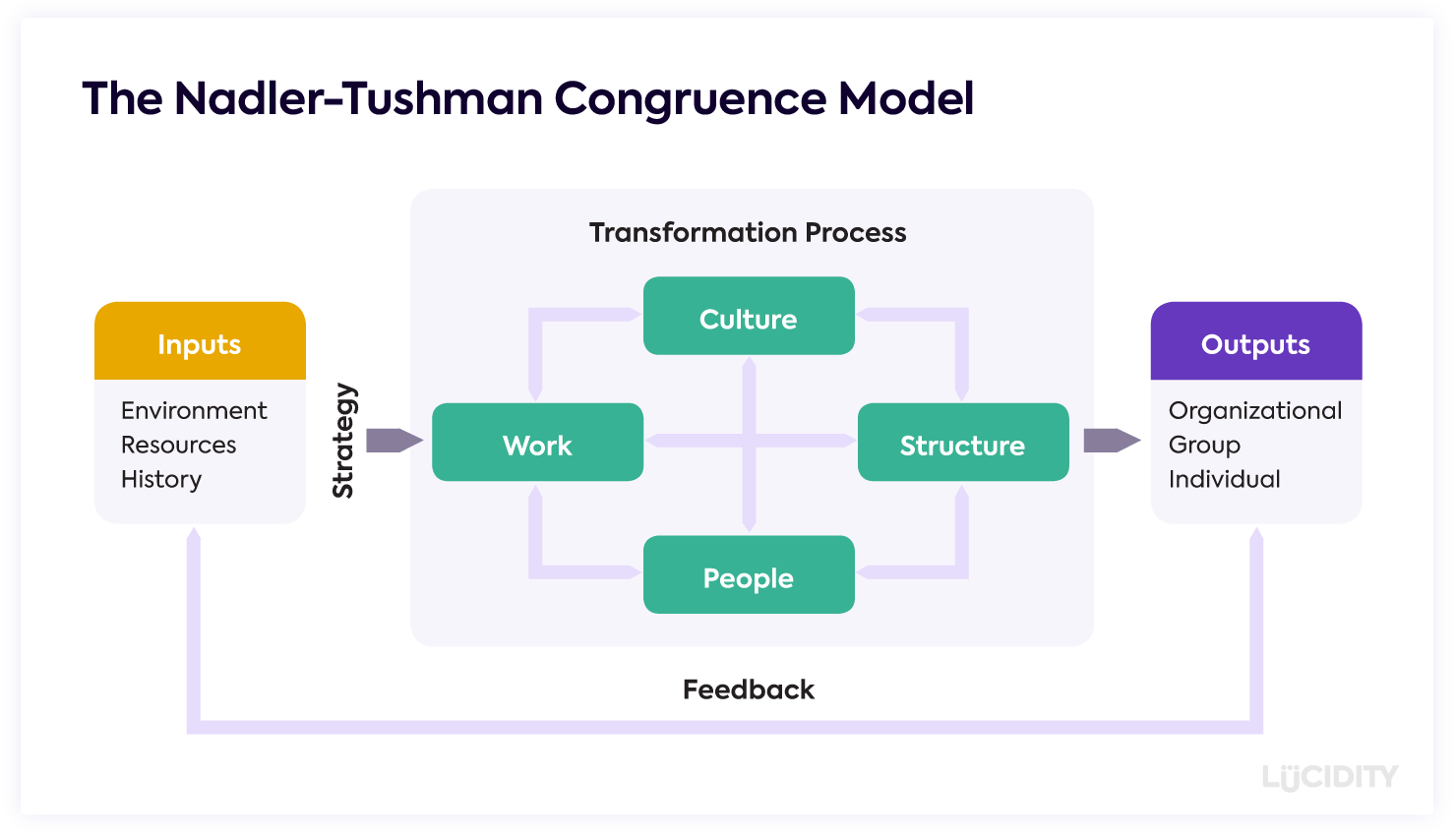We know the name isn’t that catchy, but The Nadler-Tushman Congruence Model is actually a very useful framework for understanding and resolving issues around your company performance by looking at how well things fit together.
Fit is really key for creating the best possible outcome. We’re big fans of both chocolate and green thai curry, but together would produce a questionable cake… in the same way that you could have a great culture and a great structure, but if they don’t work together you’re not going to get good results.
Let’s take a closer look…
What is The Nadler-Tushman Congruence Model?
The Nadler-Tushman Congruence Model is a model used to identify the problems around performance and how to begin to address them to improve that performance. It’s concept is based around the idea that a company will only be successful if the components of it align and work together.
The different components in the model are:
- Culture
- Work
- Structure
- People
Feeding in to and out of the above core four are:
- Input (such as your strategy)
- Output (your performance)
The model shows how the different components are all interrelated:
- Culture and Work
- Culture and Structure
- Culture and People
- Work and People
- Work and Structure
- People and Structure
The key to the performance is around how congruent these are together.
For example, you may have a fantastic, talented team, but there’s no structure in place or technology to support and align that team. That’s actually more common in all types of company than you may expect…
What is Work in The Nadler-Tushman Congruence Model?
Work looks at what the operations are within your company and how they are performed. It covers all areas of the process in getting your input as a company through to your output. That might be manufacturing with physical machines or software development with developers producing code.
What is People in The Nadler-Tushman Congruence Model?
People addresses the various individuals who produce the work, from the top management through to the various external stakeholders, including customers. This section covers everything from knowledge and skills to will and loyalty.
What is Structure in The Nadler-Tushman Congruence Model?
Structure covers the structure and processes within your company. It defines how you are setup, be it functionally, product based, country based, or a mix. The management levels, the overall org chart, and how information flows between these different units are covered. There’s some overlap with people here, as it also looks at policies, approaches, diversify, incentives, etc.
What is Culture in The Nadler-Tushman Congruence Model?
As the name suggests, this is all about describing the culture of the company. That can be difficult and you may get different answers from different team members. Consider what your core values are as a business and how work gets completed day to day. How do teams interact with each other and within themselves? How do the management or leaders behave?
How do I use The Nadler-Tushman Congruence Model?
Step One: Analyze the four components
Work through each of the four sections, Work, People, Culture, Structure, and map out the different attributes of each one.
Step Two: Map the key relationships
The model shows the relationships that need to be analysed:
Culture and Work
- How does the culture impact the work that happens?
- Does culture help or hinder work effectiveness?
- How does the work impact the culture of the business?
Culture and Structure
- Is the culture aligned to the structure?
- How would another structure align to the culture?
- Do you see friction because of a mismatch in culture and structure?
Culture and People
- Do people agree on the culture?
- Are new hires aligned to the culture?
- Do people like the culture?
- Is the culture a good fit for the people?
Work and People
- Is the work suitable for the people in the team?
- Are the skills in the business there for the work to be done?
- Do people understand the work and how it fits in to the strategy?
Work and Structure
- Are the processes in place to effectively complete work?
- Is there a better structure that will complement the work?
People and Structure
- Is the structure of the company designed to meet the needs of the people?
- Do the people fit within the structure and algin to it?
- Does the structure work for the different teams?
Step 3: Develop Congruence
This is where the answers need to start to be put into place. Compare the notes from Step 2 and decide what changes are needed to each of the four areas in order to get them working together well.
The end result of this will be a greater alignment between Work, Structure, People and Culture, and a higher performing buisness.
What are the advantage to The Nadler-Tushman Congruence Model?
The biggest advantage of the model are:
- A simple methodology for identifying issues in the business
- A clear map of the different factors is shown
- It’s a model that highlights the need for interactions between components
What are the limitations of The Nadler-Tushman Congruence Model?
The limitations of this model include:
- It provides no answers to the issues the model raises
- It is very internally focused so you’ll need something like a PESTLE at the same time
What are the alternatives to The Nadler-Tushman Congruence Model?
There’s a few ways to evaluate your performance out there. Take a look at Weisbord’s 6 Box Model. It’s a model used to analyse the effectiveness of a business in being able to execute a strategy.
Who invented The Nadler-Tushman Congruence Model?
The Nadler-Tushman Congruence Model was developed by Michael L. Tushman and David A Nadler at Columbia University in the early 1980s.















